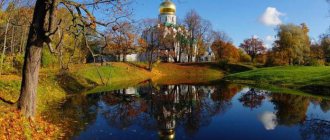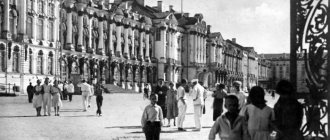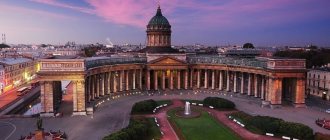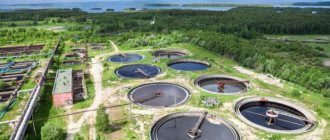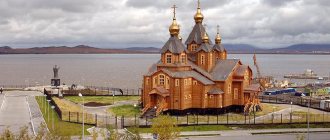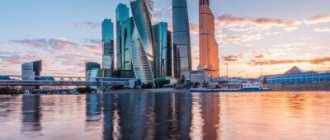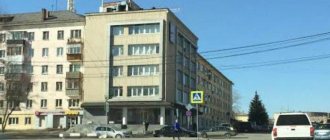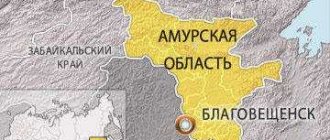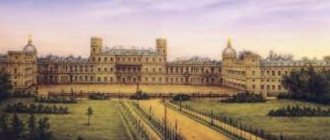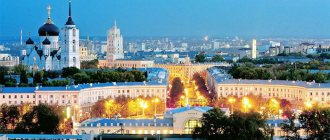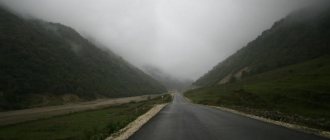Pushkin is a city near St. Petersburg. A large tourist, scientific, educational and military-industrial center. Included in the list of monuments protected by UNESCO, as part of the object “Historical Center of St. Petersburg and related complexes of monuments.”
The city is home to the Tsarskoye Selo Museum-Reserve, a monument to urban planning art and a palace and park ensemble of the 18th - early 20th centuries. The reserve includes the Catherine Park with the Catherine Palace and other buildings.
Until 1918 it was called Tsarskoe Selo, from 1918 to 1937 - Detskoe Selo.
The population of the city of Pushkin is about 110 thousand.
Pushkin was founded in 1710 as the imperial country residence of Tsarskoe Selo. Received city status in 1808.
Founding history
A Swedish magnate lived here from 1609 to 1702. His small estate was called Sarskaya Manor. It included a wooden house and utility buildings, a neat garden with two perpendicular paths dividing the territory into 4 squares.
The first mention of this village is contained in a document dating back to 1501. Then Peter I expelled the Swedish population and took possession of this land, transferring it into the hands of A. Menshikov. On June 13, 1710, this point appears under the name Tsarskoe Selo. It was presented to M. Skavronskaya, later the emperor’s wife Ekaterina Alekseevna. This moment is considered the founding date of Pushkin. At that time it played the role of a country residence.
Souvenirs
In the central part of the city, near the Catherine Palace, there are a large number of souvenir shops with products of various subjects. These include amber jewelry, themed scarves, T-shirts, mugs, hats, pendants and much more. Tourists willingly buy and take gifts to various parts of the world in memory of the sights of Pushkin and St. Petersburg.
This city still manages to maintain an atmosphere of palace secrets. While here, it is not so difficult to imagine court ladies, Catherine the Great, Alexander Pushkin, the family of the last Russian Emperor Nicholas II and even Grigory Rasputin strolling through the parks. The history of Russia comes to life on the streets of Tsarskoye Selo.
*Prices are current as of August 2021.
Improvement of the object
In the period 1718-1724. The construction of the palace and the auxiliary buildings surrounding it was carried out. They were surrounded by the greenery of a picturesque garden. Between 1719 and 1722 created 2 ponds on the terrace below.
A settlement was built nearby for the palace employees. In 1716, the Assumption Church appeared. The first street, which appeared in 1720, was Sadovaya (previously called Perednyaya). During 1721, the Kuzminskaya Sloboda was established. The peasant population of the Suzdal province lived in it.
The oldest building made of stone, the Znamenskaya Church, began to be built in 1734. The city appeared here in 1808. The local museum-reserve has become a monument to urban planning. The ensemble of the 18th-20th centuries, including the park and the Catherine Palace, as well as the buildings adjacent to them, deserves no less attention.
Catherine Palace – history and exhibitions
The compositional center of the Tsarskoye Selo ensemble is the Catherine Palace. In 1717-1714. the architect Braunstein built a rather modest stone palace for Empress Ekaterina Alekseevna, wife of Peter the Great. This palace was inherited by their daughter Elizabeth, who, having come to power, began to vigorously rebuild and expand it. In the 1740s, M. G. Zemtsov, A. V. Kvasov, S. I. Chevakinsky worked on the reconstruction, and from 1748 to 1756, F.-B. had the honor of building the current version of the palace. Rastrelli. The luxurious grand palace in the Baroque style suited the tastes of the royal owner. After her death, the next ruler, Catherine the Second, in the 1770s commissioned the architect Charles Cameron to remodel her personal chambers in the palace in accordance with the new fashion for antiquity. Further, under Alexander I, the emperor’s rooms in the palace were remodeled by V.P. Stasov, and the last reconstructions in the palace took place during the time of Alexander II in the 1860s. All these interiors, carefully restored by our restorers after destruction during the Great Patriotic War, can be seen during an excursion to the Catherine Palace.
Area, relief and climate
The area of the city of Pushkin is 201 square meters. km. It is located on the territory of the Prinevskaya lowland, to the left of the river. Not you. There are various landscape forms: plains, ridges, terraces, valleys and hills. Forests are mixed with agricultural land.
The city of Pushkin (St. Petersburg) is home to springs that feed ponds and streams. 350 million years ago (Paleozoic) there was a sea here. Clay, sands, limestone, and sandstones have survived to this day. Their layer reaches 200 m and covers a crystalline diabase, gneiss, and granite foundation. The formation of the current relief was stimulated by a cover of ice (the Valdai glaciation, which occurred 12,000 years earlier).
When thawing occurred, the Littorine Sea appeared, whose depth was 8 m greater than the current one. 4000 years ago the tide ebbed and the river appeared. The Neva is the result of post-glacial deposits. For 2.5 thousand years, right up to the present day, no changes in relief were noticed.
The local climate is characterized by moderation and humidity. It is transitional between continental and maritime. Summer doesn't last long and it's rarely hot. The winter is much longer, interrupted by thaws.
The transition periods of spring and autumn are long, so average indicators are more common for local residents. Temperatures are above freezing between April and November. The coldest month is February. The annual precipitation level is 590 millimeters.
Atmospheric currents, as a rule, are clean and fresh, enter here from the south, due to which the weather is mild. One air mass can quickly give way to another. Cyclones are frequent. The sun is least in November-January. In general, the local climate is quite comfortable for life.
Territorial division
You can get to the city center of Pushkin if you move northeast from the park area. It is mainly built up with buildings of 3-4 floors made of stone. Most of them were built in the pre-revolutionary period.
The main historical district is Sofia. Next to it are the streets. Parkovaya and Sapernaya, Pavlovskoye and Krasnoselskoye highways. Krasnoselka previously housed Arakcheevka, Babolova and Soboleva - private areas of the city. Pushkin is a place where, while exploring, you will stumble upon the Friedenthal colony, which belonged to the Germans. A large number of high-rise buildings on the territory of BAM. There was a private sector here. Also worthy of attention are Novaya Derevnya and Belozerka, Novoselki, which grew out of rural areas. Another historical district is Kondakopshino. In addition, there are zones called Pavlovsk-2, Lesnoye (belongs to the GPP), Novokondakopshino.
Many people may be interested in the question of which index to use? The city of Pushkin is divided into only 2 postal areas, so departments accept letters using the details: 196601 or 196609.
Cafes and restaurants
Finding a good restaurant or cafe in the city is not difficult; the choice is very wide. There are a lot of establishments in the city - from pretentious restaurants to bakeries. The most famous and prestigious restaurants are “Tsarskoye Selo Present” and “Admiralty”. To enjoy their exquisite cuisine, it is better to book a table in advance. Prices in most city establishments are quite affordable.
Restaurant "Admiralty" in Pushkin
National characteristics
A 19th century guidebook indicates that the population of Pushkin (St. Petersburg) was 15 thousand people. It was unlike other cities in terms of its ethnic composition.
Bourgeois, peasant people, clergy and merchants made up 7 thousand people. The remaining half consisted of military personnel, courtiers, and colonists. It was not just a quiet place to live, but an important political point.
Local society had a special coloring. Many St. Petersburg residents came here for 3 months and left the city. In 1939, in the Leningrad region, as in the entire Soviet Union, a population census was carried out, the results of which revealed that 17,711 thousand Jews lived here. When the Germans occupied the city, they were almost completely destroyed.
Accommodation options
Despite all the popularity of the city on the tourist map of Russia, it is not difficult to find a hotel here. The exception is days when holiday events and festivals take place in Pushkin. As for prices, the traditional rule applies here: the farther from the historical center, the cheaper. Thus, the cost of a room in a hostel can start from 1,500 rubles, and accommodation in a hotel near Catherine Park can start from 8,000 rubles.*
Local residents willingly offer their own real estate for accommodation to city guests. A comfortable apartment in Pushkin can be rented for 2,500 rubles per day.*
Dynamics of population change
At the beginning of the 18th century, the Sarskaya manor included more than 43 villages, 6 wastelands, peasant and bobil households. Over time, the population grew. During the reign of Peter I, 200 peasant families lived here.
The composition of the village included the church parable, guard soldiers and court servants. New villages arose, where there were 71 households, consisting of immigrants and 69 from the local population.
In 1732, a census was carried out, according to the results of which there were 48 men here. In the surrounding villages, they counted 105 Latvian households, in which representatives of the stronger and fairer sex lived in a ratio of 336/343, respectively. In 1796, the Palace Settlement included 779 buildings in which 2.8 thousand people lived. Sofia became home to 1.6 thousand people. (146 dwellings).
In 1845, Colonel Zhukovsky made a report in which it was reported that, including the garrison, the population was 121.94 thousand people. Of these, 9.066 thousand were men, 3.128 thousand were women. Hundreds of families came here in the summer to relax together with the courtyard. Workers (1-1.5 thousand people) also went to Tsarskoye Selo.
Ratna Chamber
Under the last two emperors of the Romanov dynasty, after numerous imitations of Europe and the East, everything national and Russian finally came into fashion. Nicholas and Alexandra, the last royal couple of Russia, were deeply religious people, and not far from the Alexander Palace, where they lived, construction began on the Fedorov Cathedral in the ancient Russian style. There was supposed to be a large complex of buildings around it with buildings for the clergy, barracks for the Cossack convoy and many others. Tsar Nicholas decided to make one of these white stone buildings a museum glorifying the feats of arms of the Russian army. The Sovereign's War Chamber was founded in 1913; the basis of the collection of the future museum was the collection of the wife of Pavel Tretyakov's brother. The inexorable course of history changed the original purpose of the museum - in 1914, an exhibition dedicated to the life and exploits of the Russian army during the First World War opened here. The museum was of no interest to the new government after the revolution and was disbanded. Since 2008, through the efforts of the team of the Tsarskoe Selo State Museum, the restoration of the Great War Museum has been underway. The War Chamber opened to the public in 2014 to mark the centenary of the First World War.
XX - early XXI centuries
In 1909 there were 31,201 thousand people here. Of these, 2.8 thousand were noble class, 309 were clergy, 691 were citizens with an honorary title, 241 were merchants, 2.505 thousand were bourgeois, 13.653 thousand were peasants, 52 were colonists, 8.169 thousand were military personnel. , 1.369 thousand were retirees. Foreigners with families – 237 people. Other population groups – 209 people.
The number of people increased, and within a century there were 108.3 thousand people here. 93.8 thousand people lived directly in the city of Pushkin.
The territories of Pavlovsky and Pushkinsky districts were united into a single administrative unit. In 2001, the total number of people was 124.3 thousand citizens.
In 2002, a count was carried out again, showing a total of 116,811 thousand (in the Pushkinsky district there were 100,097 thousand people). Of these, 56% were of working age. This was the moment of the first positive changes in the birth rate (it increased by 5%).
Subsequently, positive population dynamics were observed: 2003 – 84.6 thousand people, 2006 – 110.9 thousand people.
Closer to our days
The number of people living here has changed due to the rapid development of construction.
According to 2008 data, 1.278 thousand people were born, which exceeded the results of 2007. However, in order for Pushkin’s population to reproduce properly, the figure had to double. 285 people born from extramarital unions. In 60% of cases, both parents applied for registration.
In 2009, 1,471 couples entered into a marriage union, and 742 were dissolved.
There are more women than men. Of the total number, they are 54%, which is 4.5 thousand people. exceeds the number of representatives of the stronger sex. These are mostly people of non-working age. Representatives of the fair sex live longer.
The population of Pushkin has an average age of 40 years. Based on demographic and social indicators, we can talk about its aging. If the trend does not change, senior citizens will soon make up a third of the total population. In 2009, 19,316 thousand foreigners registered for migration. 1,377 people came here in search of work, 435 people received Russian citizenship.
Since 2012, a steady increase in the number of people has been noticeable:
- in 2012, the population of Pushkin was 95.239 thousand people;
- 2013 – 97.34 thousand people;
- 2014 – 100.753 thousand people;
- 2015 – 101, 101 thousand people.
In 2021, the population of Pushkin is 102.729 thousand people. Of these, 63% are able-bodied. 13% are still too young to work, 24% are already old.
Social support measures
Regional and federal authorities are faced with numerous tasks, as a result of which Russia (the city of Pushkin, in particular) will be transformed in terms of demography. Considerable attention is paid to family issues and providing parents with financial assistance.
Families are paid 15 different subsidies. Assistance is provided in supporting children while studying at school. Organizations are developing that are involved in protecting society, improving the quality of life, creating educational institutions, centers for improving health and sports. Massive events are held that emphasize the benefits of starting a family.
Many more problems remain unresolved. It is extremely important to address them as soon as possible in order to ensure an increase in the working-age population, which the city of Pushkin (St. Petersburg) desperately needs. Social guarantees for families with children are important due to the growing number of elderly citizens. In this case, young couples will not be afraid of financial difficulties when having a child.
Official site
Catherine Park - St. Petersburg
Information about the municipal formation of the city of Pushkin St. Petersburg can be found on the official website of the local administration. The portal is constantly updated. Its visitors receive news about the cultural and political life of the city, sporting events, and the achievements of Pushkin natives. Information provided by the prosecutor's office, the Ministry of Emergency Situations, the employment service, the pension fund and other structures is also published here.
But for tourists to get acquainted with the life of the city, sections of the site dedicated to excursions around Pushkin, the weather, as well as posters, electronic versions of the local press - the newspapers "Municipal Telegraph" and "Municipal Bulletin" - are of greater interest.
Amber Room of the Catherine Palace
